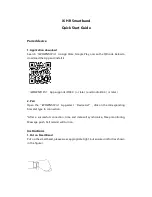
Electrical Adjustments (Continued)
8. Focus adjustment
9. Loading DDC code
The DDC HEX data should be written into the EEPROM
(7802) by EDID301.EXE Program(3138 106 10103)
and software DDC Alignment kits (4822 310 11184).
With
display at timing
,
each block is a square of
. Set brightness at 50%
and
at the center of the screen. and adjust focus
pot-meter which is located at fly-back transformer, until the haze
just disappears on 2/3 east and west, top and down of the screen.
- Make sure the monitor is not exposed to any
external magnetic field.
- Produce a full red pattern on the screen, adjust the
purity magnet rings on the PCM assy (on CRT) to
obtain a complete field of the color red. This is done
by moving the two tabs (2-pole) in such a manner
that they advance in an opposite direction but at
the same time to obtain the same angle between
the two tabs, which should be approximately 180
degree.
- Check by full green pattern and full blue pattern
again to observe their respective color purity.
Introduction
Slight deviation in the static convergence can be
corrected by using two permanent pairs of magnets
which are fitted around the neck of the CRT. These
are the 4-pole magnet and the 6-pole magnet.
The 4-pole magnet move the outermost electron
beams (R and B) parallel in the opposite direction
from the other. The 6-pole magnet moves the
outermost electron beam (R, B and G) parallel in the
opposite direction from the other.
The magnetic field of the above magnets do not affect
the center of the CRT neck.
Setting
- Before the static convergence setting can be made,
the monitor must be switched on for 30 minutes.
- The focus setting must be made correctly.
- Signal: 640 * 480, 31.5 kHz/60 Hz mode.
- Set the tabs of the 4-pole magnet in the neutral
position. This is when the tabs are opposite one
another. In this position the magnets do not affect the
deflection of the R and B electron beams.
- Set the tabs of the 6-pole magnet in the neutral
position. This is when the tabs are opposite one
another. In this position the magnets do not affect the
deflection of the R, B, and G electron beams.
- First set the 4-pole magnet optimally.
- Then set the 6-pole magnet optimally.
- If the convergence is not now optimal, then adjust to
the optimal setting with the 4-pole magnet and then with
the 6- Pole magnet again.
- Set the tabs of the 6-pole magnet in the neutral
position. This is when the tabs are opposite one
another. In this position the magnets do not affect the
deflection of the R, B, and G electron beams.
- First set the 4-pole magnet optimally.
- Then set the 6-pole magnet optimally.
- If the convergence is not now optimal, then adjust to
the optimal setting with the 4-pole magnet and then
with the 6- pole magnet again.
10. Purity adjustment
11. Static convergence
9-blocks ME pattern
79.9KHz 1280 X 1024
90mm x 90mm
contrast at 100%
2-pole purity magnet
6-pole convergence magnet
4-pole convergence magnet
Deflection Yoke
4-pole
Beam motion producced by the
4-pole convergence magnet
S
S
N
N
B
G
R
S
S
N
N
B
G
R
Beam displacement
direction
Magnetic flux
lines
6-pole
Beam motion producced by the
6- pole convergence magnet
S
S
S
N
N
N
R
B
G
S
S
S
N
N
N
R
B
G
Go to cover page
13
V50 109B5
Summary of Contents for V50 109B5
Page 7: ...9 Go to cover page 7 V500 109B5 Wiring Diagram ...
Page 25: ...C B A Of Video Board 25 9 Go to cover page V50 109B5 ...
Page 29: ...C B A Of Main Board 29 9 Go to cover page V50 109B5 ...
Page 30: ...30 V50 109B5 9 Go to cover page C B A Of Main Board ...
Page 34: ...34 V50 109B5 Control Panel board C B A 9 Go to cover page ...
Page 36: ...36 V50 109B5 MHR board C B A 9 Go to cover page ...














































